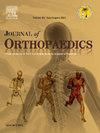Risk factors for non-compliance of patient reported outcome measures following achilles tendon repair surgery
IF 1.5
Q3 ORTHOPEDICS
引用次数: 0
Abstract
Background
Patient-Reported Outcome Measures (PROMs) are increasingly utilized in orthopaedic research and assess the patient's response to care, allow for assessment of the patient's overall health, and provide tools to promote the shared decision-making process. Our hypothesis is that risk factors for non-compliance is increasing age and increasing time after surgery.
Methods
PROMs compliance was conducted from survey data of 90 individuals from May 2017 to July 2023 who had Achilles tendon surgery. After completion of surgical intervention, patients received electronic notification with a link to complete their own patient reported outcomes survey preoperatively, and at 3-month, 6-month, 1-year, and 2-year follow-up time points. Compliance by timepoint was calculated as the proportion of patients who completed the surveys compliantly relative to the total eligible cohort offered to participate in the survey.
Results
The median age at time of surgery was 50 years [IQR 38 to 61], and the majority were male (60%). For every year increase in age at treatment, the odds of compliance increased by approximately 4.1% (OR = 0.96, 95% CI [1.00, 0.93], p = 0.047). Compliance with PROMs was highest at 3-months postoperative (77%). Patients who identified as "Not Hispanic or Latino" were approximately 3.22 times less likely to be non-compliant with the survey completion (OR = 0.31, 95% CI [0.97, 0.099], p = 0.046) at two years. Self-reported race, language, and sex at birth did not demonstrate statistically significant (p > 0.05).
Conclusions
Our hypothesis was rejected because within our study, younger age had the highest non-compliance with PROMs. Also, compliance did not decrease at every timepoint after surgery. Those identifying their ethnicity as “Hispanic or Latino” had the highest non-compliance with PROMs. Surgeons need to identify patients who are at risk for non-compliance to ensure those patients participate in completion of the outcome instrument.
Level of evidence
lll Retrospective Cohort Study.
求助全文
约1分钟内获得全文
求助全文
来源期刊

Journal of orthopaedics
ORTHOPEDICS-
CiteScore
3.50
自引率
6.70%
发文量
202
审稿时长
56 days
期刊介绍:
Journal of Orthopaedics aims to be a leading journal in orthopaedics and contribute towards the improvement of quality of orthopedic health care. The journal publishes original research work and review articles related to different aspects of orthopaedics including Arthroplasty, Arthroscopy, Sports Medicine, Trauma, Spine and Spinal deformities, Pediatric orthopaedics, limb reconstruction procedures, hand surgery, and orthopaedic oncology. It also publishes articles on continuing education, health-related information, case reports and letters to the editor. It is requested to note that the journal has an international readership and all submissions should be aimed at specifying something about the setting in which the work was conducted. Authors must also provide any specific reasons for the research and also provide an elaborate description of the results.
 求助内容:
求助内容: 应助结果提醒方式:
应助结果提醒方式:


